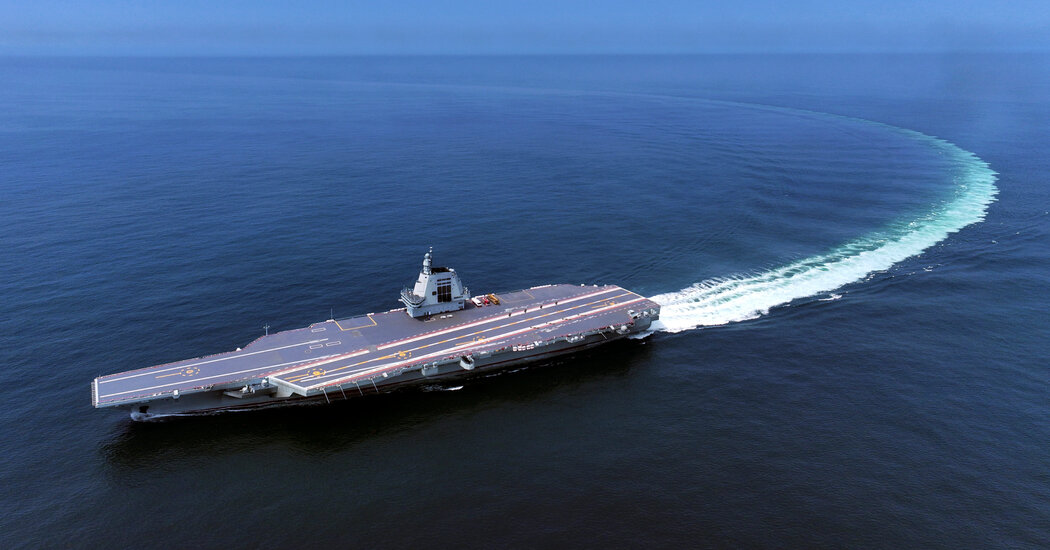Copyright The New York Times

China’s newest and most advanced aircraft carrier, the Fujian, officially entered into service this week, the country’s military announced on Friday, bringing Beijing another step closer to its goal of rivaling American naval power in the region. The Fujian, which features an electromagnetic catapult system for launching and landing aircraft, was commissioned for service on Wednesday, when China’s top leader, Xi Jinping, presided over the ceremony on Hainan, an island in the country’s south, the Liberation Army Daily and other state-run news outlets announced. Mr. Xi, dressed in army green in his role as chairman of China’s military, strode the deck of the carrier, inspecting aircraft and praising their pilots as heroes, video released by Chinese official media showed. Reports also said that Mr. Xi had “personally decided” that the Fujian should use the electromagnetic catapult equipment, a demanding technology that President Trump recently railed against. By deploying the Fujian, and with plans to construct more aircraft carriers, China is moving to assert dominance in the western Pacific, using the carriers and their accompanying forces to brandish power and intimidate adversaries, several experts said. The Fujian, the third of China’s carriers, is its most ambitious effort so far. The ship was unveiled in 2022 but took years to become proficient enough to go officially into service. China’s aircraft carriers still lag behind those of the United States, both in number and sophistication. China now has three, all running on diesel, while the United States has 11, which are all nuclear powered. But the Fujian is the first Chinese carrier to approach the U.S. carriers in size and capability. Satellite images suggest that China is already building a fourth carrier. And plans are underway to keep expanding the fleet, possibly shifting to nuclear-powered carriers at some point, despite arguments that unmanned drones and precision missiles could make the ships obsolete. “While unmanned systems are a trend, I don’t believe they will pose a major, lethal threat to aircraft carriers within the next decade,” said Jiang Hsin-biao, a researcher at the Institute for National Defense and Security Research in Taipei, which is supported by Taiwan’s Ministry of National Defense. “Even the U.S. is building new carriers, demonstrating their lasting value. The threats are relative and exist for both sides, whether it’s China or the U.S.,” he said. For Mr. Xi, the publicity around the commissioning of the Fujian may be a political salve after recent embarrassing revelations of corruption in the high ranks of the People’s Liberation Army forces. China announced in October that nine senior officers had been dismissed and faced prosecution on charges of corruption and abuses of power. They included Gen. He Weidong, who was third in China’s military hierarchy, after Mr. Xi and another commander. The Fujian’s main breakthrough is its electromagnetic catapult system for launching aircraft and slowing them to a halt when they land. The system appears similar to one used aboard the U.S.S. Gerald R. Ford, the first of the United States’ newest generation of aircraft carriers. But Mr. Trump late last month criticized the electromagnetic technology as unreliable and said he would order U.S. carriers to go back to steam-propelled launchers. “When we build aircraft carriers, it’s steam for the catapults, and it’s hydraulic for the elevators. We’ll never have a problem, OK?” Mr. Trump said on a visit to the U.S.S. George Washington, an aircraft carrier in Japan. China’s two earlier carriers, the Liaoning and the Shandong, use simpler takeoff and landing technology on decks with ski-jump-like prows. The new system could allow the Fujian to carry larger aircraft with bigger loads of weapons and to send the planes out faster with less wear on their frames. The Fujian’s deployment comes as tensions continue between China and Taiwan, an island democracy that has long rejected Beijing’s claims of sovereignty. Some analysts foresee China using the Fujian as part of carrier groups, along with battleships and submarines, that could intimidate Taiwan or countries that have territorial disputes with Beijing, especially in the South China Sea. It is unlikely that carriers would figure prominently into any initial military action by China against Taiwan, because the island is so close to the Chinese coast and its many air bases. But some experts believe China could eventually use aircraft carriers in a blockade of the island. “These aircraft carriers are, of course, not aimed solely against Taiwan,” Mr. Jiang said. “But if they’re deployed in the Western Pacific, they could encircle Taiwan.”



